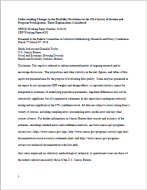
An official website of the United States government
Here’s how you know
Official websites use .gov
A .gov website belongs to an official government organization in the United States.
Secure .gov websites use HTTPS
A lock (
) or https:// means you’ve safely connected to the .gov website. Share sensitive information only on official, secure websites.
-
//
- Census.gov /
- Library /
- Census Working Papers /
- Understanding Changes in the Disability Prevalence
Understanding Changes in the Disability Prevalence in the 2014 Survey of Income and Program Participation: Three Explanations Considered
Understanding Changes in the Disability Prevalence in the 2014 Survey of Income and Program Participation: Three Explanations Considered
The Survey of Income and Program Participation contains a wealth of information on demographic, social, and health outcomes. Although many federal surveys use a common set of questions to measure disability, Wave 1 of the 2014 Survey of Income and Program Participation (SIPP) had a disability prevalence higher than other contemporaneous federal surveys. This paper seeks to explain why. We draw upon survey and collection data from the 2014 SIPP Panel and compare the prevalence of disability in the 2014 SIPP Panel with the prevalence in the 2008 SIPP, the 2010-2014 American Community Survey, and the 2010-2014 National Health Interview Survey. We use a combination of descriptive and decomposition techniques to quantify how much of the difference in the disability prevalence is related to differences in the characteristics of the samples interviewed in the 2008 and 2014 SIPP panels. Descriptive analyses are also used to test whether errors in data collection may have resulted in a higher disability prevalence. Findings suggest that the high disability prevalence in the 2014 SIPP is a function of how disability status was reported rather than: weighting, changing sample composition, or data collection error. While the high disability prevalence in the 2014 SIPP is unexpected, SIPP’s rich information and relatively large sample of people with disabilities nevertheless makes it a useful resource for researchers studying disability.
Share
Related Information
WORKING PAPER
Disability Working PapersSome content on this site is available in several different electronic formats. Some of the files may require a plug-in or additional software to view.
 Yes
Yes
 No
NoComments or suggestions?


Top

